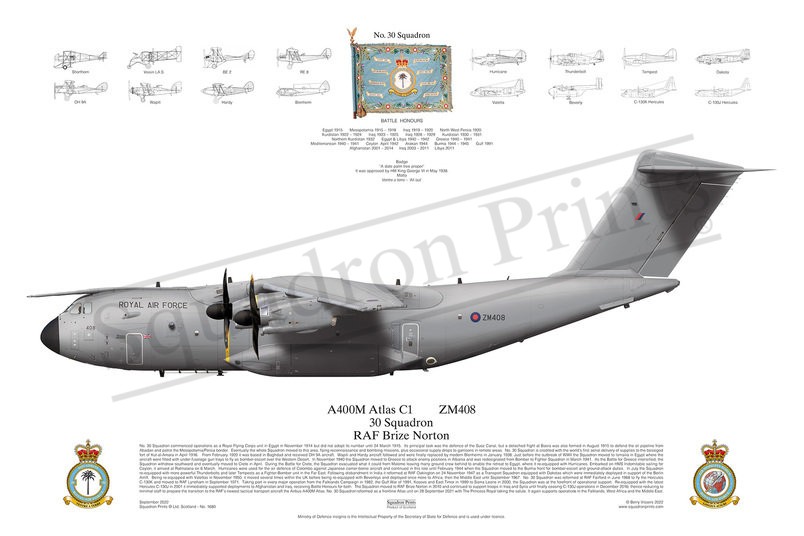#1680 30 Sqn A400M Atlas print

Description
Squadron Prints Lithograph No. 1680 - ZM408, A400M Atlas C1, 30 Squadron, RAF Brize Norton.
No. 30 Squadron commenced operations as a Royal Flying Corps unit in Egypt in November 1914 but did not adopt its number until 24 March 1915. Its principal task was the defence of the Suez Canal, but a detached flight at Basra was also formed in August 1915 to defend the oil pipeline from Abadan and patrol the Mesopotamia/Persia border. Eventually the whole Squadron moved to this area, flying reconnaissance and bombing missions, plus occasional supply drops to garrisons in remote areas. No. 30 Squadron is credited with the world’s first aerial delivery of supplies to the besieged fort of Kut-al-Amara in April 1916. From February 1920 it was based in Baghdad and received DH 9A aircraft. Wapiti and Hardy aircraft followed and were finally replaced by modern Blenheims in January 1938. Just before the outbreak of WWII the Squadron moved to Ismailia in Egypt where the aircraft were fitted with under-fuselage gun trays to fly as bomber-escort over the Western Desert. In November 1940 the Squadron moved to Greece to attack enemy positions in Albania and was redesignated from Bomber to Fighter Squadron in March 1941. As the Battle for Greece intensified, the Squadron withdrew southward and eventually moved to Crete in April. During the Battle for Crete, the Squadron evacuated what it could from Maleme leaving many ground crew behind to enable the retreat to Egypt, where it re-equipped with Hurricanes. Embarked on HMS Indomitable sailing for Ceylon, it arrived at Ratmalana on 6 March. Hurricanes were used for the air defence of Colombo against Japanese carrier-borne aircraft and continued in this role until February 1944 when the Squadron moved to the Burma front for bomber-escort and ground-attack duties. In July the Squadron re-equipped with more powerful Thunderbolts and later Tempests as a Fighter-Bomber unit in the Far East. Following disbandment in India it reformed at RAF Oakington on 24 November 1947 as a Transport Squadron equipped with Dakotas which were immediately deployed in support of the Berlin Airlift. Being re-equipped with Valettas in November 1950, it moved several times within the UK before being re-equipped with Beverleys and deployed once more to Africa, then the Middle East until September 1967. No. 30 Squadron was reformed at RAF Fairford in June 1968 to fly the Hercules C-130K and moved to RAF Lyneham in September 1971. Taking part in every major operation from the Falklands Campaign in 1982, the Gulf War of 1991, Kosovo and East Timor in 1999 to Sierra Leone in 2000, the Squadron was at the forefront of operational support. Re-equipped with the latest Hercules C-130J in 2001 it immediately supported deployments to Afghanistan and Iraq, receiving Battle Honours for both. The Squadron moved to RAF Brize Norton in 2010 and continued to support troops in Iraq and Syria until finally ceasing C-130J operations in December 2016; thence reducing to minimal staff to prepare the transition to the RAF’s newest tactical transport aircraft the Airbus A400M Atlas. No. 30 Squadron reformed as a frontline Atlas unit on 28 September 2021 with The Princess Royal taking the salute. It again supports operations in the Falklands, West Africa and the Middle East.
You may also like
-
A-10C Thunderbolt II, 163th FS Squadron Print
82-0661 '163 FS'163 FS, 122 FWBaer Field, Fort Wayne IAP Indiana -
Twin Otter; DASH-7
VP-FAZ; VP-FBQBritish Antarctic SurveyHalley Research Station; Rothera Base -
Braveheart Formation Tornado F3
ZE342; ZE207; ZE834; ZE296; ZE73443 SqnRAF Leuchars
